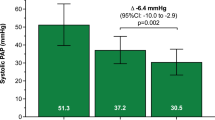Abstract
The present study aimed to investigate the factors associating with the presence of residual thrombosis in patients with acute pulmonary embolism (APE) after at least 3-month anticoagulant therapy. Demographic and clinical data of 180 cases in the affiliated hospital of Qingdao University from January 2005 to June 2015 were retrospectively analyzed. APE in all patients were confirmed by computed tomography pulmonary angiography (CTPA). Patients were then detected for the presence of residual thrombosis according to a second CTPA. After appropriate comparison test, multivariate logistic regression analysis was performed to identify predictors for residual thrombosis. Among 180 patients, complete clearance of thrombosis occurred in 115 (63.9%) patients. Residual thrombosis remained in 65 (36.1%) patients. The independent factors associating with residual thrombosis include unprovoked APE (OR 0.231, 95% CI 0.062–0.861) and fibrinogen level in acute phase (OR 1.958, 95% CI 1.282–2.911). Furthermore, these two variables were both associated with the presence of residual thrombosis in patients receiving different parenteral anticoagulants (unfractionated heparin or low-molecular-weight heparin). Pulmonary thrombosis in some patients with APE are not completely dissolved after at least 3-month treatment. Additionally, unprovoked APE is positive predictor of decreased residual thrombosis and fibrinogen level in acute phase is a risk factor of the presence of residual thrombosis.

Similar content being viewed by others
References
Torbicki A, Perrier A, Konstantinides S et al (2008) Guidelines on the diagnosis and management of acute pulmonary embolism. Eur Heart J 29:2276–2315
He JC, Xiansheng (2002) The epidemiology of pulmonary thromboembolism. Natl Med J China 82:1730–1731
Tapson VF (2008) Acute pulmonary embolism. N Engl J Med 358:1037–1052
Fiessinger JN, Huisman MV, Davidson BL et al (2005) Ximelagatran vs low-molecular-weight heparin and warfarin for the treatment of deep vein thrombosis: a randomized trial. JAMA 293:681–689
Meneveau N, Ider O, Seronde M-F, Chopard R, Davani S, Bernard Y, Schiele F (2013) Long-term prognostic value of residual pulmonary vascular obstruction at discharge in patients with intermediate-to high-risk pulmonary embolism. Eur Heart J 34:693–701
Agnelli G, Becattini C (2010) Acute pulmonary embolism. N Engl J Med 363:266–274
Klok FA, Zondag W, van Kralingen KW, van Dijk AP, Tamsma JT, Heyning FH, Vliegen HW, Huisman MV (2010) Patient outcomes after acute pulmonary embolism: a pooled survival analysis of different adverse events. Am J Respir Crit Care Med 181:501–506
Alonso-Martínez JL, Anniccherico-Sánchez FJ, Urbieta-Echezarreta MA, García-Sanchotena JL, Herrero HG (2012) Residual pulmonary thromboemboli after acute pulmonary embolism. Eur J Intern Med 23:379–383
Sanchez O, Helley D, Couchon S, Roux A, Delaval A, Trinquart L, Collignon MA, Fischer AM, Meyer G (2010) Perfusion defects after pulmonary embolism: risk factors and clinical significance. J Thromb Haemost 8:1248–1255
Authors/Task Force Members, Konstantinides SV, Torbicki A et al (2014) 2014 ESC guidelines on the diagnosis and management of acute pulmonary embolism: the task force for the diagnosis and management of acute pulmonary embolism of the european society of cardiology (ESC) endorsed by the european respiratory society (ERS). Eur Heart J 35:3033–3069
Qanadli SD, El Hajjam M, Vieillard-Baron A et al (2001) New CT index to quantify arterial obstruction in pulmonary embolism: comparison with angiographic index and echocardiography. Am J Roentgenol 176:1415–1420
Eichinger S, Heinze G, Jandeck LM, Kyrle PA (2010) Risk assessment of recurrence in patients with unprovoked deep vein thrombosis or pulmonary embolism. Circulation 121:1630–1636
Kim NH, Delcroix M, Jenkins DP et al (2013) Chronic thromboembolic pulmonary hypertension. J Am Coll Cardiol 62:D92–D99
Wartski M, Collignon M-A (2000) Incomplete recovery of lung perfusion after 3 months in patients with acute pulmonary embolism treated with antithrombotic agents. J Nucl Med 41:1043
Aghayev A, Furlan A, Patil A, Gumus S, Jeon KN, Park B, Bae KT (2013) The rate of resolution of clot burden measured by pulmonary CT angiography in patients with acute pulmonary embolism. Am J Roentgenol 200:791–797
den Exter PL, van Es J, Kroft LJ et al (2015) Thromboembolic resolution assessed by CT pulmonary angiography after treatment for acute pulmonary embolism. Thromb Haemost 114:26–34
Zhai ZG, Wang J (2012) The pathogenesis of chronic thromboembolic pulmonary hypertension. Natl Med J China 92:1807–1809
Stein PD, Yaekoub AY, Matta F, Janjua M, Patel RM, Goodman LR, Gross ML, Denier JE (2010) Resolution of pulmonary embolism on CT pulmonary angiography. Am J Roentgenol 194:1263–1268
Author information
Authors and Affiliations
Corresponding author
Ethics declarations
Conflict of interest
All authors declare that they have no conflict of interest to state.
Rights and permissions
About this article
Cite this article
Wang, J., Xu, M., Sun, N. et al. Factors associating with the presence of residual thrombosis after 3-month treatment of acute pulmonary embolism. J Thromb Thrombolysis 45, 27–35 (2018). https://doi.org/10.1007/s11239-017-1561-6
Published:
Issue Date:
DOI: https://doi.org/10.1007/s11239-017-1561-6




